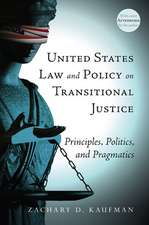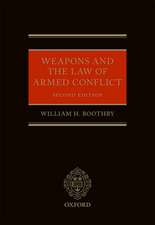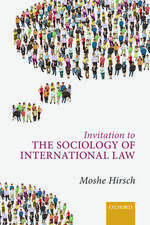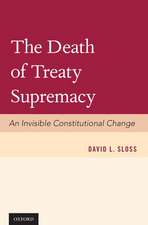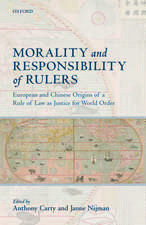Intertemporal Linguistics in International Law: Beyond Contemporaneous and Evolutionary Treaty Interpretation: Studies in International Law
Autor Julian Wyatten Limba Engleză Hardback – 11 dec 2019
| Toate formatele și edițiile | Preț | Express |
|---|---|---|
| Paperback (1) | 314.01 lei 6-8 săpt. | |
| Bloomsbury Publishing – 14 iul 2021 | 314.01 lei 6-8 săpt. | |
| Hardback (1) | 571.24 lei 3-5 săpt. | |
| Bloomsbury Publishing – 11 dec 2019 | 571.24 lei 3-5 săpt. |
Din seria Studies in International Law
- 34%
 Preț: 511.07 lei
Preț: 511.07 lei - 30%
 Preț: 538.77 lei
Preț: 538.77 lei - 23%
 Preț: 249.26 lei
Preț: 249.26 lei - 34%
 Preț: 512.30 lei
Preț: 512.30 lei - 21%
 Preț: 275.26 lei
Preț: 275.26 lei - 30%
 Preț: 570.51 lei
Preț: 570.51 lei - 30%
 Preț: 598.45 lei
Preț: 598.45 lei - 18%
 Preț: 297.20 lei
Preț: 297.20 lei - 30%
 Preț: 573.05 lei
Preț: 573.05 lei - 30%
 Preț: 1138.79 lei
Preț: 1138.79 lei -
 Preț: 448.39 lei
Preț: 448.39 lei - 30%
 Preț: 571.34 lei
Preț: 571.34 lei - 28%
 Preț: 406.31 lei
Preț: 406.31 lei - 21%
 Preț: 270.97 lei
Preț: 270.97 lei - 30%
 Preț: 570.43 lei
Preț: 570.43 lei - 30%
 Preț: 836.82 lei
Preț: 836.82 lei - 14%
 Preț: 570.43 lei
Preț: 570.43 lei - 30%
 Preț: 512.37 lei
Preț: 512.37 lei - 30%
 Preț: 511.14 lei
Preț: 511.14 lei - 30%
 Preț: 954.11 lei
Preț: 954.11 lei - 30%
 Preț: 572.47 lei
Preț: 572.47 lei - 30%
 Preț: 603.73 lei
Preț: 603.73 lei - 30%
 Preț: 779.50 lei
Preț: 779.50 lei - 14%
 Preț: 837.54 lei
Preț: 837.54 lei - 30%
 Preț: 898.78 lei
Preț: 898.78 lei - 30%
 Preț: 576.40 lei
Preț: 576.40 lei - 30%
 Preț: 719.91 lei
Preț: 719.91 lei - 30%
 Preț: 599.66 lei
Preț: 599.66 lei - 12%
 Preț: 233.46 lei
Preț: 233.46 lei - 30%
 Preț: 779.50 lei
Preț: 779.50 lei - 30%
 Preț: 570.43 lei
Preț: 570.43 lei - 14%
 Preț: 779.09 lei
Preț: 779.09 lei - 30%
 Preț: 540.38 lei
Preț: 540.38 lei - 30%
 Preț: 573.86 lei
Preț: 573.86 lei - 14%
 Preț: 574.92 lei
Preț: 574.92 lei - 28%
 Preț: 500.25 lei
Preț: 500.25 lei - 30%
 Preț: 542.02 lei
Preț: 542.02 lei - 30%
 Preț: 778.12 lei
Preț: 778.12 lei - 30%
 Preț: 540.48 lei
Preț: 540.48 lei - 30%
 Preț: 570.43 lei
Preț: 570.43 lei - 30%
 Preț: 515.24 lei
Preț: 515.24 lei - 30%
 Preț: 573.70 lei
Preț: 573.70 lei - 30%
 Preț: 720.23 lei
Preț: 720.23 lei - 30%
 Preț: 784.00 lei
Preț: 784.00 lei - 22%
 Preț: 571.24 lei
Preț: 571.24 lei - 14%
 Preț: 779.09 lei
Preț: 779.09 lei - 30%
 Preț: 779.91 lei
Preț: 779.91 lei
Preț: 571.24 lei
Preț vechi: 817.39 lei
-30% Nou
Puncte Express: 857
Preț estimativ în valută:
109.32€ • 113.71$ • 90.25£
109.32€ • 113.71$ • 90.25£
Carte disponibilă
Livrare economică 24 martie-07 aprilie
Preluare comenzi: 021 569.72.76
Specificații
ISBN-13: 9781509929498
ISBN-10: 1509929495
Pagini: 336
Dimensiuni: 156 x 234 mm
Greutate: 0.64 kg
Editura: Bloomsbury Publishing
Colecția Hart Publishing
Seria Studies in International Law
Locul publicării:London, United Kingdom
ISBN-10: 1509929495
Pagini: 336
Dimensiuni: 156 x 234 mm
Greutate: 0.64 kg
Editura: Bloomsbury Publishing
Colecția Hart Publishing
Seria Studies in International Law
Locul publicării:London, United Kingdom
Caracteristici
Ground-breaking approach to treaty interpretation, drawing on law, linguistics and philosophy
Notă biografică
Julian Wyatt is a Barrister and Solicitor in Melbourne and a Visiting Fellow at the Australian National University, Canberra.
Cuprins
1. Introduction I. The Problem of Intertemporal Linguistics II. Scope III. Methodological Features IV. Structure PART ITHE PROBLEM - DETACHING IT FROM THE DOCTRINES2. The Rise and Fall of the Principle of Contemporaneity I. Surfacing and Consecration of the Static Approach as the Principle of Contemporaneity II. The Decline and Fall of the Principle of Contemporaneity III. Time to Detach the Principle of Contemporaneity from the Problem 3. The Emergence and Splitting of the Evolutionary Treaty Interpretation Doctrine I. Emergence as an Amalgam of Interpretative and Progressive Approaches II. Splitting of the Doctrine into Distinct Interpretative and Progressive FormsIII. Jettisoning a Doctrine No Longer Sufficiently Linked to the Problem 4. Refocusing on and Defining the Static and Dynamic Approaches to the Problem of Intertemporal Linguistics I. The Need for Analytical Definitions of the Problem and the Approaches to it II. Preliminary Refinements of the Nature of the Problem III. Using Linguistics to Refi ne the Key Notion of 'Different Meanings' PART IITHE MISCONCEPTIONS - CASTING ASIDE THE CONVENTIONAL WISDOM5. The VCLT's Interpretative Rules do not Solve the Problem I. The VCLT's Interpretative Provisions are Temporally Neutral II. By Authorising Progressive Adjudication, the VCLT does not Endorse a Dynamic Approach to the Problem III. Only ex ante Guidance Can Solve the Problem, Mere ex post Justification Cannot IV. Conclusions6. The Post-Namibia International Case Law does not Provide a General Solution to the Problem I. The Conception is Based on the Wrong Set of International Cases II. Seen in their Decisional Contexts, the Authorities for the View do not Adequately Support it III. Conclusions PART IIITHE SOLUTION - INNOVATING INSIDE INTERNATIONAL LAW7. The Problem of Intertemporal Linguistics as an Issue of Ambiguity, Not Vagueness I. Interpretation Resolves Either Vagueness or Ambiguity II. The Choice Between an Original and Later-emerging Meaning Calls for the Resolution of Ambiguity, Not Vagueness III. The VCLT Rules are Focused on Resolving Vagueness, but Implicitly Recognise the Ambiguity/Vagueness Distinction IV. Interpreters Disambiguate before they 'De-vaguefy' 8. Disambiguating Original and Later-emerging Senses Using a Temporal Sense-Intention I. Disambiguation is Achieved Through Identifying the Sense-Intention II. The Sense-Intention is Very Different to Other Interpretative Intentions III. The Relevant Sense-Intention in the Intertemporal Linguistics Context is a 'Temporal Sense-Intention' IV. Notions Akin to the Temporal Sense-Intention Emerging from Case Law and Scholarship Relating to the Problem 9. Features of Interpretative Situations that Might Imply a Temporal Sense-Intention I. Sense-Intentions are Usually Inferred from Context II. 'By Definition Evolutionary' and 'Generic' Terms as Indicia of a Mobile Sense-Intention III. Terms that Constitute Legal Concepts as Indicia of a Mobile Sense-Intention IV. Terms in Human Rights Treaties as Inherently Possessing a Mobile Sense-Intention V. Terms in Territorial Treaties as Inherently Possessing a Fixed Sense-Intention VI. Terms in Treaties of Fixed and Continuing Durations as Implying Fixed and Mobile Sense-Intentions Respectively VII. Terms in Constitutive Instruments as Implying a Mobile Sense-Intention VIII. Terms in Clauses Establishing a Situation and Laying Down a Rule Respectively IX. Implications of a Temporal Sense-Intention Arising from the Number of Parties to a Treaty X. Concluding Observations on the Interpretative Features Cited by the Case Law and Scholarship 10. Organising the Features into a Workable Method for Inferring the Temporal Sense-Intention and Solving the Problem I. Context Including Definitions - The Best Evidence of Sense-Intention II. Where Context Runs Out - Using Other Indicia and Presumptions for Inferring the Temporal Sense-Intention III. Presumptions - Strong and Independent Indicators of a Particular Temporal Sense-Intention IV. Mere Indicia - Indicators that Taken Together May Clearly Imply a Fixed or Mobile Sense-Intention V. Twin Presumptions of Last Resort - Using the Number of Treaty Parties VI. Practical Benefits of the Proposed Method for Solving the Problem 11. Conclusion I. Summary II. A Plea for a Less Flexible and More Legally Certain System of Treaty Interpretation


